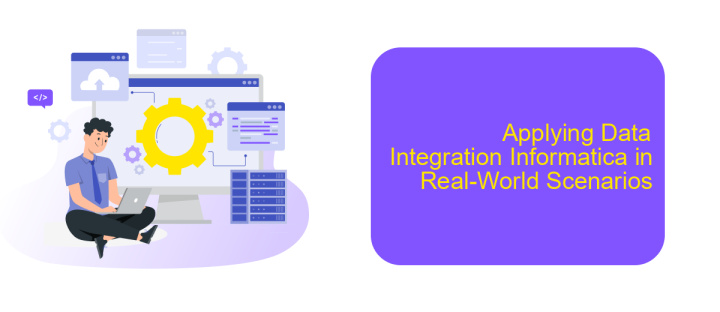Data Integration Informatica
Data integration is a critical aspect of modern business intelligence, enabling organizations to consolidate data from various sources into a unified view. Informatica, a leader in data management solutions, offers robust tools and platforms for seamless data integration. This article explores the key features, benefits, and best practices of using Informatica for effective data integration, ensuring accurate and timely insights for informed decision-making.
Introduction to Data Integration Informatica
Data Integration Informatica is a powerful tool designed to streamline the process of integrating data from various sources into a unified view. It enables organizations to manage, transform, and consolidate data from disparate systems, ensuring accurate and timely information for decision-making.
- Seamless integration with multiple data sources
- Comprehensive data transformation capabilities
- Robust data quality and governance features
- Scalable architecture for growing data needs
- Support for real-time and batch processing
For those looking to simplify the setup of their integrations, services like ApiX-Drive can be highly beneficial. ApiX-Drive offers an easy-to-use platform for connecting various applications and automating data flows without the need for extensive coding. By leveraging such tools alongside Informatica, organizations can achieve a more efficient and reliable data integration process.
Benefits of Using Data Integration Informatica

Data Integration Informatica offers numerous benefits that can significantly enhance business operations. One of the primary advantages is its ability to streamline data from various sources into a single, cohesive system. This integration eliminates data silos, ensuring that all departments have access to consistent and up-to-date information. Consequently, this leads to better decision-making, improved efficiency, and enhanced collaboration across the organization.
Additionally, Informatica's robust data integration capabilities are complemented by its user-friendly interface and powerful tools. It supports a wide range of data formats and sources, making it versatile for different business needs. Services like ApiX-Drive can further simplify the integration process by automating data transfers between applications, reducing the need for manual intervention. This not only saves time but also minimizes the risk of errors, ensuring that data is accurate and reliable. Overall, using Data Integration Informatica can lead to more agile and responsive business processes, driving growth and innovation.
Key Features of Data Integration Informatica

Data Integration Informatica is a powerful tool designed to streamline data management processes, ensuring seamless data flow across various systems and applications. Its robust features make it a preferred choice for organizations looking to enhance their data integration capabilities.
- Comprehensive Data Connectivity: Informatica supports a wide range of data sources, including databases, cloud services, and big data platforms, ensuring comprehensive data connectivity.
- Advanced Data Transformation: The platform offers sophisticated data transformation capabilities, enabling users to cleanse, enrich, and standardize data efficiently.
- Real-Time Data Integration: With real-time data integration, Informatica ensures that data is always up-to-date, facilitating timely decision-making processes.
- Scalability and Performance: Informatica's architecture is designed for scalability, allowing it to handle large volumes of data without compromising on performance.
- Data Quality Management: The tool includes robust data quality management features, ensuring the accuracy and reliability of integrated data.
- API Integration: Informatica seamlessly integrates with various APIs, including services like ApiX-Drive, to automate and simplify data integration workflows.
These key features of Data Integration Informatica highlight its versatility and effectiveness in managing complex data environments. By leveraging such capabilities, organizations can ensure data consistency, enhance operational efficiency, and drive better business outcomes.
Applying Data Integration Informatica in Real-World Scenarios

Data integration using Informatica is a powerful approach to managing and consolidating data from various sources into a unified view. This process is crucial for businesses that rely on accurate and timely data to drive decision-making and operational efficiency. By leveraging Informatica's robust tools, organizations can seamlessly integrate data across different platforms and applications.
In real-world scenarios, companies often face challenges such as data silos, inconsistent data formats, and the need for real-time data processing. Informatica provides solutions to these challenges through its comprehensive suite of data integration tools, which include data extraction, transformation, and loading (ETL) capabilities. These tools ensure that data is consistently formatted and readily available for analysis.
- Centralizing customer data from multiple CRM systems.
- Integrating financial data from various accounting software.
- Synchronizing inventory data between e-commerce platforms and warehouse management systems.
- Aggregating social media data for sentiment analysis.
- Combining sales data from different regional offices for unified reporting.
Additionally, services like ApiX-Drive can complement Informatica by automating the integration of various applications and services without the need for extensive coding. ApiX-Drive simplifies the process of connecting different data sources, ensuring that data flows smoothly and efficiently across the organization. This combination of Informatica and ApiX-Drive can significantly enhance an organization's data integration strategy.
- Automate the work of an online store or landing
- Empower through integration
- Don't spend money on programmers and integrators
- Save time by automating routine tasks
Conclusion and Future Prospects of Data Integration Informatica
In conclusion, Data Integration Informatica has proven to be a robust and versatile solution for managing complex data environments. Its ability to seamlessly integrate various data sources and provide real-time analytics has positioned it as a critical tool for organizations aiming to leverage their data for strategic decision-making. The platform's user-friendly interface and comprehensive features make it accessible to both technical and non-technical users, fostering a collaborative approach to data management.
Looking ahead, the future prospects for Data Integration Informatica are promising. With the growing importance of data in driving business success, the demand for advanced data integration solutions is expected to rise. Innovations in artificial intelligence and machine learning will further enhance Informatica's capabilities, making data integration more intelligent and automated. Additionally, the integration of services like ApiX-Drive can simplify the process of connecting various applications, enabling businesses to streamline their workflows and improve operational efficiency. As the data landscape continues to evolve, Informatica is well-positioned to adapt and lead the way in data integration technology.
FAQ
What is Data Integration in Informatica?
How does Informatica handle data transformation?
What are the key components of Informatica PowerCenter?
How can you automate data integration tasks in Informatica?
What are the benefits of using Informatica for data integration?
Do you want to achieve your goals in business, career and life faster and better? Do it with ApiX-Drive – a tool that will remove a significant part of the routine from workflows and free up additional time to achieve your goals. Test the capabilities of Apix-Drive for free – see for yourself the effectiveness of the tool.


